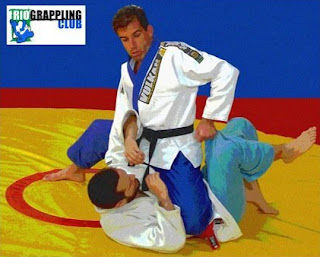What rank do you currently hold in BJJ and who awarded it to you?
I was just awarded my fourth stripe on the black belt by my Master Sergio Souza Bolão last Saturday after 14 years holding a black belt.
When did you start doing bjj and how would you describe your first experience?
I started in 1990 and it was very humbling, with smaller guys dominating me at will...
What drove you to start doing BJJ?
I was sick of capoeira and its loose ethics and discipline so when i first saw guys fighting in the ground, i was surprised with a sport with so much leverage and technique and wanted to learn more and more until I got sucked into it and quit everything else to dedicate my life to BJJ.
What is the most important thing you learned from your coach?
Impossible to mention one thing only, I learned a lot not only from him but also from previous coaches, training partners and even from my fellow opponents in competitions. BJJ helped me in so many ways in life that is hard to come up with only one thing.
What do you like about teaching BJJ?
The opportunity to travel around and meet people from different backgrounds.
What makes a good BJJ coach?
Dedication, love for the sport, commitment to the group, experience, skills, patience, leadership and more patience...
Do you think competition is a good way to improve your skills?
Yes it is the ultimate test and everyone should give it a try. You may not become a World Champion but the wins and losses will teach you many things impossible to learn if you limit yourself to train inside your own group. If you don't compete, you will take longer to learn and will always miss that important part of the sport.
What advice would you give to white belts who want to improve their game?
Choose carefully your coach and the group first of all, and try to learn properly the basics. Learning the Tornado or Deep Half Guard will not take you to the next level, but learning well to escape from the mount and the side control in real sparring will.
BJJ has often been likened to chess, do you think that is accurate?
Well I have said that a couple of months ago to my friends and followers in Facebook, BJJ is actually a lot more complex than Chess. In Chess you use the brains and you and the opponent make one move at a time, and in BJJ you must also train the body to follow your mind, your heart must step up to the challenge, and you both move simultaneously, there are a lot more options and less time to think, all in all BJJ is a lot more than a physical chess in my opinion.
What are your three favorite techniques?
I have tens I like but I prefer to repeat what I heard once from Rickson Gracie: if you like BJJ, you must enjoy everything, from the best situation to the most uncomfortable ones, this is the only way forward if you want to excel in BJJ
Roberto will be visiting South Africa in April and will be visiting his affiliated schools in Gauteng, Cape Town, Port Elizabeth and he will also be visiting Windhoek in Namibia for the first time. For more info on his South African tour go to riograpplingclub.net or got to http://www.riograpplingclub.com for info on Rio Grappling Club.
We here at My Jiu Jitsu Blog would also like to congratulate Roberto with the receipt of his fourth degree last week.




















